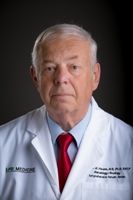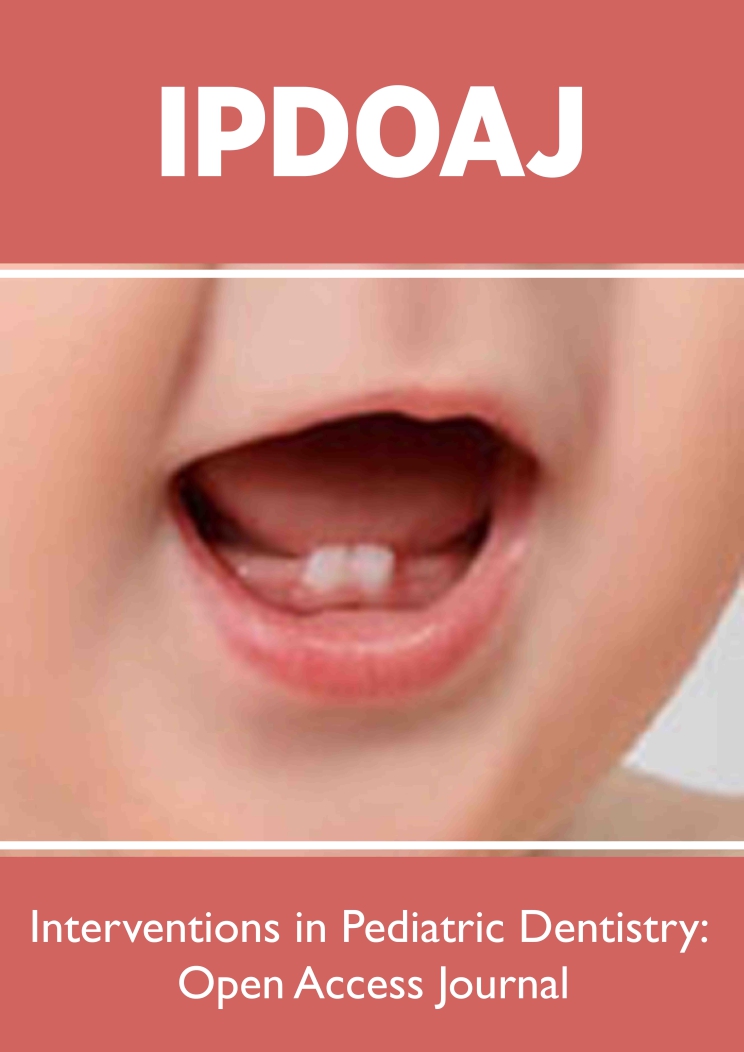
Lupine Publishers Group
Lupine Publishers
Menu
ISSN: 2637-6636
Research Article(ISSN: 2637-6636) 
Early Childhood Caries Prevalence and Severity in Relation to Oral Health Behaviors in Lebanese Pre-School Children Volume 8 - Issue 4
Hisham Hassan Tabbara*
- Primary Health Care Corporation (PHCC), Doha, Qatar
Received: May 02, 2022; Published: May 25, 2022
*Corresponding author: Hisham Hassan Tabbara, Primary health care corporation (PHCC), Doha, Qatar
DOI: 10.32474/IPDOAJ.2022.08.000291
Abstract
The purpose of this study is to assess the impact of selected dental health behaviors on the prevalence and severity of Early
Childhood caries (ECC), among a group of Lebanese preschool children. A total of 500 preschool children, age 3 to 5 years were
chosen with stratified random sample technique with proportional allocation of the subjects, into different strata. Out of the 500
students chosen, 409 complied and returned the questioner and hence were included in the study. The study was performed in six
schools distributed in different areas of Beirut, 3 private and 3 public schools. Every child was examined using a disposable plastic
dental mirror under an adequate source of light. Early childhood caries was diagnosed as present when one or more decayed (non
cavitated or cavitated lesions), missing (due to caries), or filled tooth surface on any primary tooth in children up to 71 months of
age [1] was detected. The severity of ECC was classified according to Whyne AH (1999) [2]. Type 1 ECC (mild to moderate); Type
2 ECC (moderate to severe); Type 3 ECC (severe). All eligible children were given a questionnaire to be filled in at home by parents
and returned by a specific date. Dental health behaviors included in the questionnaire were as follows: Age of commencement of
tooth brushing, Adult supervision of tooth brushing, Amount of toothpaste used, Application of toothpaste, Dummy use with and
without sweetener, Previous visits to dentist and selection of labels with no added sugar. The data were collected, tabulated and
statistically analyzed, using package for social science “SPSS” version 13. The age of the study sample ranged from 3- 5 years with
a mean 4.0 ± 0.9. About half of the sample was males (49.1%). The majority of children were in public schools (60.9%). Nearly
all children (93.4%) brushed their teeth. Two thirds (68.8%) however, started brushing at or after 24 months of age. Most of the
children (91.1%) were supervised by their parents during brushing and 75.1% of them used an amount of tooth paste that was half
the length of the toothbrush. This amount was put on the brush by parents in 73.8% of the cases. Nearly a quarter of the children
(23%) used the pacifier whether alone or with sweetener. Only 30.1% choose drinks without sugar. More than half of the examined
children (53.3%) had not previously visited a dentist. Of those who had caries, 38.9% had mild caries, 27.1% had moderate caries
while only 4.4% had severe caries. The mean age increased significantly (P<0.0001) with increasing severity of caries (for no caries,
mild, moderate and severe caries, mean ages= 3.7 ± 0.8, 4.1 ± 0.9, 4.3 ± 0.8 and 4.4 ± 0.7 respectively). No significant difference was
observed between males and females in caries severity (P= 0.87). More children in public school had severe caries compared to
children in private schools (6.8% and 0.6% respectively). Similarly, more children in private schools were caries free compared to
children in public schools (49.4% compared to 16.9% respectively). The difference between children in public and private schools
in caries severity was statistically significant (P Keywords: Early childhood caries; oral hygiene habits; dental health behaviors; tooth brushing Dental caries is the most common chronic disease that can be
prevented in children [3]. Previous studies reported the prevalence
rate of dental caries to be 27.3-69.5% among preschool children
[4-6]. Children’s dental caries not only influence their wellbeing [7]
quality of life [8] and growth [9] but can be a risk factor for caries in
permanent teeth [10]. As early childhood caries starts on surfaces
that can be easily accessed by routine tooth brushing, oral hygiene
levels may be associated with caries risk. Increased frequency and
better oral hygiene levels are associated with lower caries levels
in preschool children. Several studies show that increased tooth
brushing frequency and parental involvement decrease carious
lesions on smooth surfaces [11-15]. However, a study reports that
the absence of tooth brushing is not associated with a greater
prevalence of incisor caries [12],while others find no relationship
between tooth brushing frequency and caries [13-16]. Additionally,
except for one report [12],studies investigating the age of tooth
brushing demonstrate few associations with caries status [17-19].
Studies that assess plaque scores or gingival status in preschool
children find a positive and significant association between
gingivitis, mutans streptococci levels and caries [13,20]. Studies
also declared that dental caries could be associated with oral
health behavior, eating habits, and frequency of tooth brushing in
children [4,6,21-23]. Most studies also show that dental knowledge
is positively related to caries prevalence. That is, parents who have
high scores on dental knowledge usually have children with high
caries levels. Regardless of the anomalous finding, these studies
confirm the generally agreed-upon principle that education alone is
insufficient to produce behavior change [24]. More investigations
should be conducted to clarify the parents’ knowledge about their
children’s oral health behavior accurately and to identify what they
need to improve it [25]. The present study was conducted to access the impact of dental
health behaviors on the prevalence and severity of ECC among a
group of Lebanese preschool children. It’s a descriptive, cross
sectional study that included various public and private pre-schools
in Lebanon. Disposable plastic mirrors were used for screening after
drying the area to be examined and before deciding the presence
and severity of ECC. The examination was conducted in each school
in a prepared room with a suitable source of light for screening,
were the child was seated on an ordinary straight back chair. A total
of 500 preschool children, aged 3 to 5 years were chosen with the
stratified random sample technique with proportional allocation of
the subjects, into different strata. Out of 500 students chosen, 409
complied and returned the questioner and hence were included
in the study. The study was performed in schools distributed in
different areas of Beirut. The students in these schools came from
different areas in Lebanon. And hence the results obtained could
be generalized on all Lebanese preschool
children. The selected
schools where three private and three public schools. As for the
private schools the students in the study sample were distributed
as follows: a) The first school with 54 students. b) The second school with 45 students. c) The third school with 61 students. The students in the public schools were distributed as follows: a. The forth school with 128 students. b. The fifth school with 55 students. c. The sixth school with 66 students. Intra-examiner calibration was done before starting the survey
where ten children were examined under the supervision of the
main supervisor in order to make sure that the investigator achieved
optimally uniform examination and to minimize variations which
might affect the judgment of the examiner and hence the diagnosis.
Every child was examined using a disposable plastic dental mirror
with an adequate source of light. Early childhood caries was
diagnosed as present when one or more decayed (non cavitated or
cavitated lesions), missing (due to caries), or filled tooth surface
on any primary tooth in children up to 71 months of age [1] was
detected. The severity of ECC was classified according to Whyne AH
(1999) [2]. The existence of isolated carious lesion(s) involvi ng molars
and / or incisors. Labiolingual carious lesions affecting maxillary incisors, with
or without molar caries, and unaffected mandibular incisors. Carious lesions affect almost all the teeth including the lower
incisors. All eligible children were given a questionnaire to be filled
in at home by the parents and returned by a specific date. Out of
500 students given the questionnaire, 409 returned the filled
questionnaire on the specific date. Dental health behaviors included in the questionnaire are Age,
Gender, Age of commencement of tooth brushing, Adult supervision
of tooth brushing, Amount of toothpaste used, Application of
toothpaste, Dummy use with and without sweetener, Previous
visits to dentist, Selection of labels with no added sugar. Descriptive
statistics were calculated in the form of frequencies and percents for
qualitative variables and mean and standard deviation or medians
for quantitative variables. The relation between caries severity
and quantitative variables was analyzed using analysis of variance
while chi square was used for analysis of association between caries
severity and qualitative variables. Significant associations in these
bivariate analyses were used to build an ordinal regression model
to predict factors affecting caries severity. In all cases, significance
was set at the 5% level. Statistical analysis was performed using
SPSS version 13. In order to study the impact of dental health behaviors on
the prevalence and severity of ECC, this epidemiologic survey
was conducted among 409 preschool children in Lebanon. The
data were collected, tabulated and statistically analyzed, using
package for social science “SPSS” version 13. And since we have a
responsibility, as researchers, to insure and defend the credibility
of our work, intra-examiner consistency has been assessed before
collecting the data. Table 1 shows the personal characteristics of the
study sample. The age of the study sample ranged from 3- 5 years
with a mean 4.0 ± 0.9. About half of the sample was males (49.1%).
The majority of children were in public schools (60.9%). Table 2
show the relation between caries severity and oral hygiene habits.
Significantly more children who brushed were caries free compared
to non-brushers (30.6% and 14.8% respectively, P<0.0001). more
children who started brushing at 12 and 18 months were caries
free compared to children who started brushing at 24 months or
later (55.8%, 50.7%, 20.8% and 20.3% respectively, P<0.0001).
No relation was observed between caries severity and parental
supervision of brushing, amount of toothpaste placed on brush
or who places toothpaste on toothbrush (P= 0.10, 0.06 and 0.10
respectively). Table 3 shows the relation between caries severity
and other dental habits. Significantly more children who did not
use pacifier were caries free compared to those who used the
pacifier alone or with sweetener (33.7%, 16.7% and 0 respectively,
P=0.009). Significantly more children who chose sugarless drinks
were caries free compared to those who did not choose sugarless
drinks (39.8% and 25.2% respectively, P=0.02). More children
who have previously visited a dentist were caries free compared
to children with no prior visits (36.1% and 23.9% respectively, P=
0.003). Table 4 shows caries prevalence and severity in the study
sample. One third of the examined children was caries free (29.6%).
Of those who had caries, 38.9% had mild caries, 27.1% had
moderate caries while only 4.4% had severe caries. Table 5 shows
the relation between caries severity and personal characteristics.
The mean age increased significantly (P<0.0001) with increasing
severity of caries (for no caries, mild, moderate and severe caries,
mean ages= 3.7 ± 0.8, 4.1 ± 0.9, 4.3 ± 0.8 and 4.4 ± 0.7 respectively).
No significant difference was observed between males and females
in caries severity (P= 0.87). More children in public school had
severe caries compared to children in private schools (6.8% and
0.6% respectively). Similarly, more children in private schools were
caries free compared to children in public schools (49.4% compared
to 16.9% respectively). The difference between children in public
and private schools in caries severity was statistically significant
(P This study was undertaken primarily to determine the possible
association of certain dental health behaviors on the prevalence and
severity of ECC among a group of Lebanese preschool children. The
social data showed the personal characteristics of the study sample,
and the family characteristics. The severity of caries increased
significantly with increased age (p<0.0001). This finding was in
agreement with many studies [25-27]. A possible explanation
might be that the longer the teeth subjected to certain dietary and
behavioral attitudes the more liable they were to decay. Therefore,
the severity of caries increased as the age increased from 3 to 5
years [25]. More children in public schools had severe caries,
compared to those in private schools. Similarly, more children
in private schools were caries free compared to those in public
schools. The difference between children in public and private
schools in caries severity was statistically significant (p<0.0001).
These results came in agreement with many studies in Europe [28-
32] and Middle East [33] which demonstrated the powerful effect
of social class on oral health status. Lower socioeconomic classes in
poor areas in Lebanon usually place their children in public schools
with minimum fees contrary to higher socioeconomic classes which
place their children in expensive private schools. Social class may influence caries risk in several ways.
Individuals from lower socioeconomic status experience financial,
social and material disadvantage, that compromise their ability to
care for themselves, obtain professional health care services and
live in a healthy environment [34], all of which lead to reduced
resistance to oral and other diseases [35] . As for the gender no
significant difference was observed between males and females
in caries severity (p=0.87). This result agrees with a study [36]
and disagrees with another study [37], were boys showed a
significantly higher ECC severity index compared to girls (p=0.01)
. The study showed caries prevalence and severity, where (29.6%)
of the examined children were caries free, (70.4%) had
caries and were distributed as follows: (38.9%) had mild caries,
(27.1%) had moderate caries while only (4.4%) had severe caries.
Regarding the relation between canes severity and oral hygiene
regimen, significantly more children who brushed their teeth were
caries free compared to non-brushers (p<0.0001). This comes in
agreement with many studies conducted in European countries
[11,13,38] where the daily frequency of tooth brushing had been
shown to be a major determinant of ECC experience. However, no
such relationship was noted in a study in the united states [16]. Also,
another study showed higher MS, initial DMFS scores and greater
increments of caries for children who brushed their teeth more
frequently than other children [39], with no clear explanation for
this correlation. More children who started brushing earlier at 12
and 18 months were caries free compared to children who started
brushing at 24 months or later (p<0.0001). This agrees with a study
[38], while other studies investigating the age of tooth brushing
demonstrate few associations with caries status [18,19,40]. The relation between carries severity and parental supervision
of tooth brushing was not significant (p= 0.10). This agrees with
other studies which showed that adult supervision of children’s
toothbrushing was not associated with ECC experience [37], while it disagrees with other studies where parental assistance and
brushing was a major determinant in ECC experience [11,13,38].
As for the amount of toothpaste placed on the brush and who places
it on the brush, there was no relation observed with caries severity
(p=0.06). This disagrees with another study which found that there
was as significantly increased prevalence and severity of ECC in
children that applied a full brush length of toothpaste compared
with children that applied a pea sized amount of toothpaste (p<
0.0001) [37]. Also another study recommended that parents apply
only a pea sized amount of dentifrice for their young children [41].
Also, who placed the toothpaste on the brush had no significant
relation with carries severity (p= 0.10). This comes in agreement
with another study, where who applied the toothpaste on the brush
had no significant effect on ECC experience [37]. This might be due to
the fact that applying the toothpaste on the brush can be done even
by that child due to the simplicity of application and hence has no
effect on caries severity. The results of the relation between caries
severity and other dental habits showed that significantly more
children who did not use pacifier where caries free compared to
those who used the pacifier alone or with the sweetener (p=0.009).
This agrees with many studies, which showed that ECC may occur
and children who are given sweetened pacifiers [16,42,43]. Also another study showed that there was an increased ECC
experience in children given a pacifier with sweetener compared
with children given a pacifier only or not given a pacifier at all
(p= 0.007) [37]. The explanation might be that pacifiers dipped
in sugar solutions or honey, on prolonged contact with the teeth
were cariogenic. This was due to the prolonged use of the pacifier,
where it might stay in the child’s mouth overnight [salivary flow
is less during sleep], or for many hours during the day. More
children whose parents chose sugarless labels where caries free
compared to those who were not given sugarless labels. This comes
in agreement with many studies [44,45]. Sugarless labels decrease
the liability of dental decay unlike labels containing sugar which is
highly cariogenic and hence in addition to other factors might lead
to ECC. In studies of preschool children the total weight intake of
sugar items does not vary between those with and without caries
[46,47] or only shows minor differences [48]. However, many
studies have found an association between the frequency of sugary
intake and caries [11-14,48-51]. The above mentioned dental
health behaviors including choosing sugar free labels and not using
a pacifier reflect parental dental knowledge and education which
lead to lower ECC experience. More children who had previously
visited a dentist where caries free compared to children with no
prior visits (p= 0.003). This agreed with a study [52], while it
contradicts another study [53]. A possible explanation is that when
a child had a previous visit to a dentist, necessary intervention and
parental counseling had been supplied. The present study has contributed to knowledge about the
ECC experience and selected dental health behaviors in a group
of Lebanese pre-school children aged 3 to 5 years, at private and
public schools in Beirut. The results of this study showed that the
prevalence of ECC was found to be (70.4%). As for the severity
(38.2%) had mild early childhood caries, (27.1%) had moderate
early childhood caries, while only (4.4%) had severe early childhood
caries. ECC was not found in (29.6%), who were caries free. The
findings showed that ECC and certain dental health behaviors are
significantly associated since children who brushed their teeth
were significantly more caries free compared to non-brushers.
The earlier they started to brush, the more they were caries free.
Children who had previous visits to the dentist were more caries
free compared to children with no prior visits. Caries severity could
be predicted from factors such as when was brushing started and
using the pacifier. In addition to healthy oral practice, oral health
awareness programs, especially among parents and caregivers,
prevention should be established through applying pit and fissure
sealants and fluoride in pre-schools.Introduction
Materials and Methods
Type 1: Early Childhood Caries (mild to moderate).
Type 2: Early Childhood Caries (moderate to severe).
Type 3: Early childhood caries (severe).
Results
Discussion
Conclusion
References
Editorial Manager:
Email:
pediatricdentistry@lupinepublishers.com

Top Editors
-

Mark E Smith
Bio chemistry
University of Texas Medical Branch, USA -

Lawrence A Presley
Department of Criminal Justice
Liberty University, USA -

Thomas W Miller
Department of Psychiatry
University of Kentucky, USA -

Gjumrakch Aliev
Department of Medicine
Gally International Biomedical Research & Consulting LLC, USA -

Christopher Bryant
Department of Urbanisation and Agricultural
Montreal university, USA -

Robert William Frare
Oral & Maxillofacial Pathology
New York University, USA -

Rudolph Modesto Navari
Gastroenterology and Hepatology
University of Alabama, UK -

Andrew Hague
Department of Medicine
Universities of Bradford, UK -

George Gregory Buttigieg
Maltese College of Obstetrics and Gynaecology, Europe -

Chen-Hsiung Yeh
Oncology
Circulogene Theranostics, England -
.png)
Emilio Bucio-Carrillo
Radiation Chemistry
National University of Mexico, USA -
.jpg)
Casey J Grenier
Analytical Chemistry
Wentworth Institute of Technology, USA -
Hany Atalah
Minimally Invasive Surgery
Mercer University school of Medicine, USA -

Abu-Hussein Muhamad
Pediatric Dentistry
University of Athens , Greece

The annual scholar awards from Lupine Publishers honor a selected number Read More...




